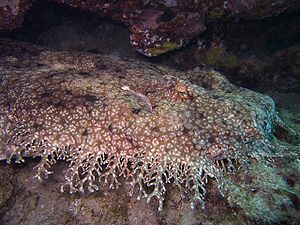Fringed carpet shark
| Fringed carpet shark | ||||||||||||
|---|---|---|---|---|---|---|---|---|---|---|---|---|

Fringed Carpet Shark ( Eucrossorhinus dasypogon ) |
||||||||||||
| Systematics | ||||||||||||
|
||||||||||||
| Scientific name of the genus | ||||||||||||
| Eucrossorhinus | ||||||||||||
| Regan , 1908 | ||||||||||||
| Scientific name of the species | ||||||||||||
| Eucrossorhinus dasypogon | ||||||||||||
| ( Bleeker , 1867) |
The fringed carpet shark ( Eucrossorhinus dasypogon ) is a shark from the family of carpet sharks up to 125 cm long . It occurs in the southwestern Pacific.
Appearance and characteristics
The fringed carpet shark is a medium-sized, ground-living shark with an average length of 1.00 to 1.20 m, the maximum size extends to over 1.25 m. Like all carpet sharks, it has a very broad, flattened body with a broad head and a large, terminal mouth.
The basic color is beige-greenish or yellowish-brown, and it is equipped over the entire body with a reticulated pattern with large dark spots that lie like a saddle on the body. This body pattern represents a camouflage color which, in its natural habitat, causes the animal to visually blur with the rock and coral floor. The two dorsal fins are very far back, so that the beginning of the first dorsal fin lies above the pelvic fins. Like other carpet sharks, the pectoral and ventral fins are very large and wide.
On the lower edge of the upper lip, under the nose and eyes, as well as below the mouth on the chin area, the shark has very heavily branched skin flaps. The mouth opening is far in front of the head in front of the eyes. The animals have a very large injection hole behind their eyes on both sides and 5 gill slits in front of the pectoral fins.
Way of life
Very little is known about the behavior and biology of the fringed carpet shark. It is a predominantly nocturnal species in the coral reef area of the continental shelf, where it lives on the corals or near the sea floor. During the day it hides in caves or under coral ledges with its tail curled up. The animals feed mainly on bottom-living fish and probably also on crustaceans, octopuses, other bottom-living invertebrates and sea anemones.
It is probably viviparous like other carpet sharks, the juvenile sharks being born with an average body length of 20 cm. The animals reach sexual maturity at a length of approximately less than 117 cm (smallest sexually mature individual captured).
distribution
The fringed carpet shark occurs in the southwestern Pacific from the Indonesian islands of Waigeo and Aru via New Guinea to the coasts of northern Australia . The preferred habitat are coral reefs close to the coast , where he can be found in the area of the coral surfaces and the channels.
Existence and endangerment
In the IUCN Red List , the fringed carpet shark is listed as not endangered (“least concern”).
supporting documents
- ↑ Description mainly based on Compagno et al. 2002
- ↑ Eucrossorhinus dasypogon in the Red List of Threatened Species of IUCN , 2015. Posted by: Huveneers, C. & Pillans, RD, 2015. Accessed October 15, 2015.
literature
- LJV Compagno : Sharks of the world. An annotated and illustrated catalog of shark species known to date. Volume 2. Bullhead, mackerel and carpet sharks (Heterodontiformes, Lamniformes and Orectolobiformes). FAO Species Catalog for Fishery Purposes. No. 1, Vol. 2. FAO Rome 2001 ( Complete PDF , Orectolobidae , species portrait )
- Leonard Compagno, Marc Dando, Sarah Fowler: Sharks of the World . Princeton University Press, Princeton and Oxford 2005, ISBN 978-0-691-12072-0 , p. 161.
